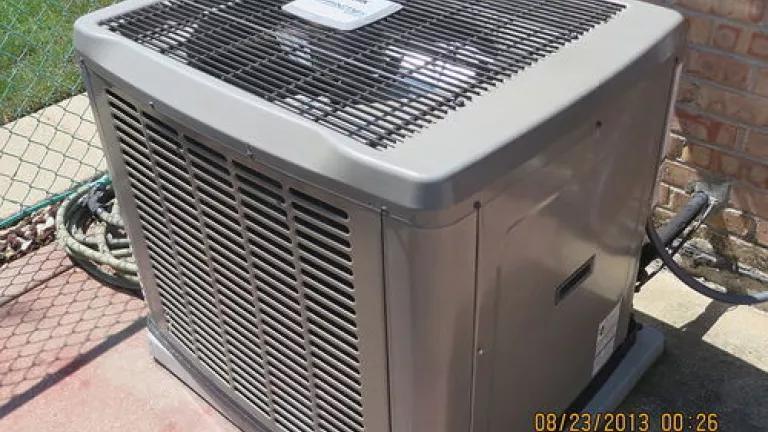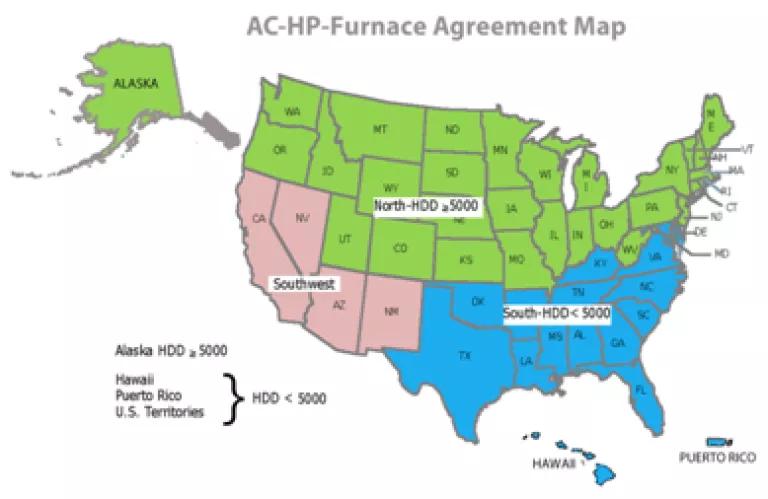
As a winter storm threatens the east coast and rain pounds the west, the efficiency of your air conditioner is likely the last thing on your mind. But summer will be here before we know it and a vote taken today will help ensure central air conditioning becomes a whole lot more energy efficient.
In fact, a consensus agreement reached this week for updated energy efficiency standards for residential air conditioners and heat pumps will save an estimated 2.8 quadrillion BTUs (quads) of energy over 30 years of sales. That's equivalent to 300 billion kilowatt-hours of electricity, enough to cool all US households for about a year and a half. These electricity savings will cut utility bills on the order of $38 billion cumulatively over the life of the rule and carbon dioxide pollution emissions by about 175 million metric tons over the same period.
The products covered by this agreement - residential air conditioners and heat pumps - are the central systems found in 68 percent of single family homes in the US, as well as in about half of multifamily units and manufactured homes.
Once finalized, updated standards for these products will add to the large savings achieved last year through updated standards for rooftop commercial air conditioners and other product categories. For comparison, the commercial AC standard - the largest standard ever set will save 15 quads. At approximately 2.8 quads, the updated standards for residential central air conditioners and heat pumps are quite significant.
Standards set according to this agreement are expected to save 13 million metric tons of carbon dioxide by 2030, adding to the 2.2 billion metric tons already on the books toward meeting President Obama's 3 billion ton goal from standards set during this administration.
How did the agreement come about?
The agreement is the result of several months of negotiation between efficiency advocates, air conditioner manufacturers, utilities, distributors, contractors, and the Department of Energy (DOE). The negotiation was conducted through DOE's formal negotiated rulemaking or "reg neg" process. The 15-member negotiating committee approved the agreement unanimously yesterday and today, DOE's Appliance Standards and Rulemaking Federal Advisory Committee (ASRAC) officially approved the term sheet. Next, DOE will translate the term sheet into a formal rule, which we expect to be finalized by the end of the year.
How much will the new standards improve efficiency?
The agreement will require air conditioners and heat pumps to be at least 7 to 8 percent more efficient than the least efficient models available today, beginning in 2023. This represents a 50 percent energy efficiency improvement since national standards first took effect for air conditioners in 1992. It also represents a 29 percent heating efficiency improvement for heat pumps over the same time frame.
What products are covered?
The agreement covers resident central air conditioners and heat pumps, which can either come in a single package or as a "split system" comprised of an outdoor compressor unit and an indoor coil. Split systems are much more common - if you have central air conditioning, you may have noticed the big outdoor unit on your roof or in your backyard. Air conditioners can be standalone systems with their own fan or be paired with a gas furnace, in which case, they generally use the furnace blower to circulate air to the rest of the house. Heat pumps are air conditioners that are able to use electricity to both heat or cool through the use of a reversing valve. While you may have noticed that your outdoor unit makes the air around it hotter during the summer, a heat pump switches directions in the winter and heats the air inside.
An outdoor compressor unit. (Licensed under Creative Commons by SA 3.0)
A little bit of history
The agreement builds upon the current standards for air conditioners and heat pumps which were set in 2011 and took effect last year. Those standards were also set based on a consensus agreement between industry and advocates and set the first-ever regional efficiency standards. While most federal efficiency standards are set at a single level nationally, DOE has the authority to set regional standards for certain products. This makes sense in the case of air conditioners, where product use and therefore cost-effectiveness varies depending on the weather. A higher efficiency level makes more sense in the south, where air conditioners run for many hours of the year, than in the north where they don't run as often.
Another important aspect of the 2011 standard was the use of a second efficiency metric in the hot, dry southwestern climates. Air conditioners perform differently depending on how hot it is outside and are generally rated using the Seasonal Energy Efficiency Ratio, or SEER metric, which estimates performance over the range of temperatures seen in a typical cooling season. The SEER metric is heavily weighted toward performance at 82 degrees F, where many air conditioners spend a good chunk of their operating hours. In the hot dry southwestern climates, however, a greater portion of those hours are spent at 90 degrees and above. Peak electricity load - the load on the electric transmission grid on the hottest days - is also a primary concern for the southwestern states. Due to these regional variations, a second metric was set for the southwest region in 2011: the Energy Efficiency Ratio (EER). EER measures performance at a single outdoor temperature, 95 degrees F, and is a better estimate of both overall and peak performance in hot, dry climates.

What's in the agreement approved today?
The agreement maintains the same regions for air conditioners as agreed to in the last standard and recommends the following standards for split system air conditioners (based on the current test procedure):
- SEER would increase to 14 in the north and to 15 for products under 45,000 Btu/hr and 14.5 for products over 45,000 Btu/hr in the southwest and southeast, from the current levels of 13 and 14 today.
- Maintains current EER requirements in the southwest for equipment with a SEER of less than 16 of 12.2 for small equipment and 11.7 for large equipment
- For equipment with a SEER of 16 or above, the southwestern EER requirement would decrease to 10.2.
The change in the EER requirement helps accommodate products - such as mini split air conditioners - which can achieve very high SEERs but often have lower EERs. The revised levels will help provide energy saving benefits not fully captured in the test procedure, while maintaining a floor on EER. Furthermore products at 16 SEER and above are almost exclusively two-speed and variable speed units, which can have the ability to reduce their use in response to a signal from the grid in order to help control load on peak summer days.
For heat pumps, the agreement recommends single national standard:
- 15 SEER and 8.8 Heating Season Performance Factor (HSPF), up from 14 SEER, 8.2 HSPF today.
Since heat pumps can both heat and cool, a single national standard makes sense for these products. Standards for packaged air conditioners and heat pumps, which represent a small share of the market, will stay the same as they are today.
All standards will take effect January 1, 2023.

The agreement also contains provisions related to test procedures, how compliance is certified, and to address quality installation of air conditioners, which is a significant further opportunity for energy savings.
Specifically, the agreement requires that every single and two-speed split system outdoor unit meet the standard in its least efficient "coil only" combination. Currently, manufacturers can test a split system with or without a blower, and the blower gives an additional efficiency boost. Requiring units to comply in the least efficient coil-only combination will raise the bar for all outdoor units.
On the test procedure, we agreed to raise the external static pressure (ESP is a measure of how hard the fan must work to push air through ducts) used in the test for most central air conditioners and heat pumps to 0.5 inches of water column (with exceptions for certain niche product categories). This new ESP value will be more representative of field conditions and better capture actual energy use of these products. The agreement also includes an update to the default power assumed for the fan for units tested as coil-only products and the addition of an optional test at 5 degrees F for heat pumps.
